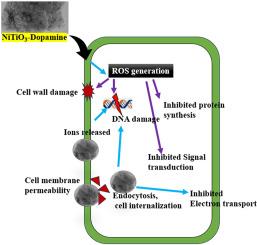Biocompatible NiTiO3–Dopamine nanocomposites for combating drug-resistant pathogens through membrane disruption and oxidative stress
IF 4.9
3区 医学
Q1 PHARMACOLOGY & PHARMACY
Journal of Drug Delivery Science and Technology
Pub Date : 2025-09-19
DOI:10.1016/j.jddst.2025.107553
引用次数: 0
Abstract
The rising threat of multidrug-resistant pathogens poses a challenge to public health. Highlighting the urgent need for novel antimicrobial agents, this study reports the synthesis of NiTiO3 nanoparticles and dopamine-functionalized NiTiO3 nanocomposites. Structural and elemental confirmation was obtained through XPS studies, which confirmed the presence of Ni2+ and Ti4+ in the nanocomposite, along with C 1s and O 1s peaks corresponding to dopamine coating. Photoluminescence spectra revealed that the NiTiO3–dopamine nanocomposite exhibits notable green emission bands at 510, 518, and 527 nm which arises from deep-level recombination associated with complex oxygen-related defects like oxygen vacancies. The NiTiO3-dopamine exhibited enhanced antimicrobial activity against S. aureus, B. subtilis, K. pneumoniae, S. dysenteriae, and C. albicans, compared to NiTiO3 alone. Minimum Inhibitory Concentration (MIC) and Minimum Bactericidal Concentration (MBC) assays further revealed that NiTiO3–dopamine achieved MIC at 600 μg/mL and MBC at 1000 μg/mL for K. pneumoniae, outperforming pure NiTiO3. ROS assays confirmed oxidative stress-mediated antimicrobial action, with ROS levels significantly quenched in the presence of histidine. SEM images of bacterial morphology showed extensive membrane disruption in NiTiO3–dopamine treated cells. Furthermore, zebrafish embryo assays confirmed excellent biocompatibility of the NiTiO3–dopamine nanocomposite, with normal development observed up to 72 h post fertilization.

通过膜破坏和氧化应激对抗耐药病原体的生物相容性nitio3 -多巴胺纳米复合材料
耐多药病原体日益严重的威胁对公共卫生构成挑战。鉴于对新型抗菌药物的迫切需求,本研究报道了纳米NiTiO3和多巴胺功能化NiTiO3纳米复合材料的合成。通过XPS研究得到了结构和元素的确认,证实了纳米复合材料中存在Ni2+和Ti4+,以及与多巴胺涂层对应的c1s和o1s峰。光致发光光谱显示,纳米复合材料在510、518和527 nm处表现出明显的绿色发射带,这是由氧空位等复杂氧相关缺陷引起的深能级重组引起的。与单独使用NiTiO3相比,NiTiO3-多巴胺对金黄色葡萄球菌、枯草芽孢杆菌、肺炎克雷伯菌、痢疾杆菌和白色念珠菌的抗菌活性增强。最低抑菌浓度(MIC)和最低杀菌浓度(MBC)测试进一步表明,NiTiO3 -多巴胺对肺炎克雷伯菌的MIC为600 μg/mL, MBC为1000 μg/mL,优于纯NiTiO3。ROS测定证实氧化应激介导的抗菌作用,ROS水平在组氨酸存在下显着淬灭。细菌形态的SEM图像显示,nitio3 -多巴胺处理的细胞中广泛的膜破坏。此外,斑马鱼胚胎实验证实了nitio3 -多巴胺纳米复合材料具有良好的生物相容性,在受精后72小时内仍能正常发育。
本文章由计算机程序翻译,如有差异,请以英文原文为准。
求助全文
约1分钟内获得全文
求助全文
来源期刊
CiteScore
8.00
自引率
8.00%
发文量
879
审稿时长
94 days
期刊介绍:
The Journal of Drug Delivery Science and Technology is an international journal devoted to drug delivery and pharmaceutical technology. The journal covers all innovative aspects of all pharmaceutical dosage forms and the most advanced research on controlled release, bioavailability and drug absorption, nanomedicines, gene delivery, tissue engineering, etc. Hot topics, related to manufacturing processes and quality control, are also welcomed.

 求助内容:
求助内容: 应助结果提醒方式:
应助结果提醒方式:


